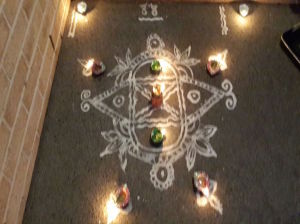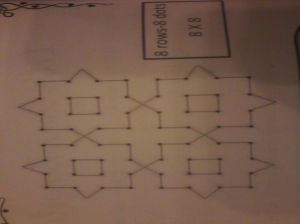Margazhi Kolams – What is the spiritual significance of Rangolis/Kolams?
A traditional and auspicious art form of India, ‘Kolam/Rangoli’ art is drawn on floor at home entrances to welcome divine forces home. A ‘kolam’ is a must to start anything auspicious, big or small. Ranging from simple everyday designs to elaborate masterpieces that mark festivities and other occasions, forms of this art have evolved through the ages and with regional variations. As with any other art form, a symmetrically and balanced ‘Kolam’ design draws heavy inspiration from nature and are artistic patterns which are pleasing to see with a calming effect on mind.
Nowadays a special field of science called ‘Cymatics’ explores relationship between harmonic vibrations (in sound domain) and the geometric patterns corresponding to them in visual modes. Modern research publications establish that shapes and colors activate neural circuitry and affect emotions positively. Hence, ‘Kolam’ is not just an art but actually a science of vibration pattern which was discovered thousands of years ago and been made a part of Indian culture for spiritual, aesthetic & scientific purposes.
Materials such as rice powder, white rock powder, red sand powder, other natural and synthetic colour powders, and fresh flowers are used for creating this art. In olden days people preferred to draw kolams in rice flour for one important reason. Small birds like sparrow and tiny insects like ants peck and feed on the rice flour, which constitutes a type of Bhootha yagna, one of the five yagnas to be followed by every human being. During Margazhi, the auspicious month for Bhakthi, drawing kolams at homes is yet another expression of love towards Lord Krishna and welcome Him home everyday.




